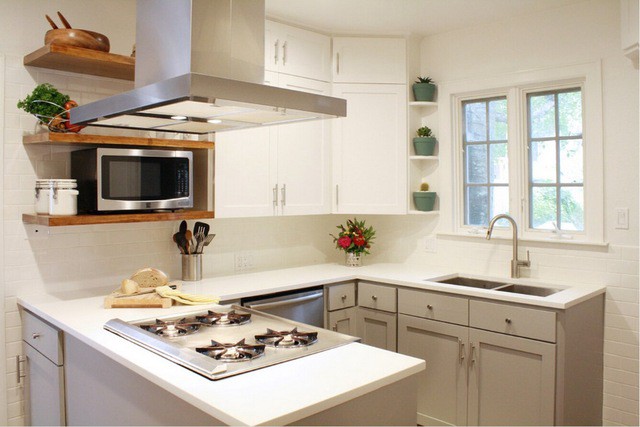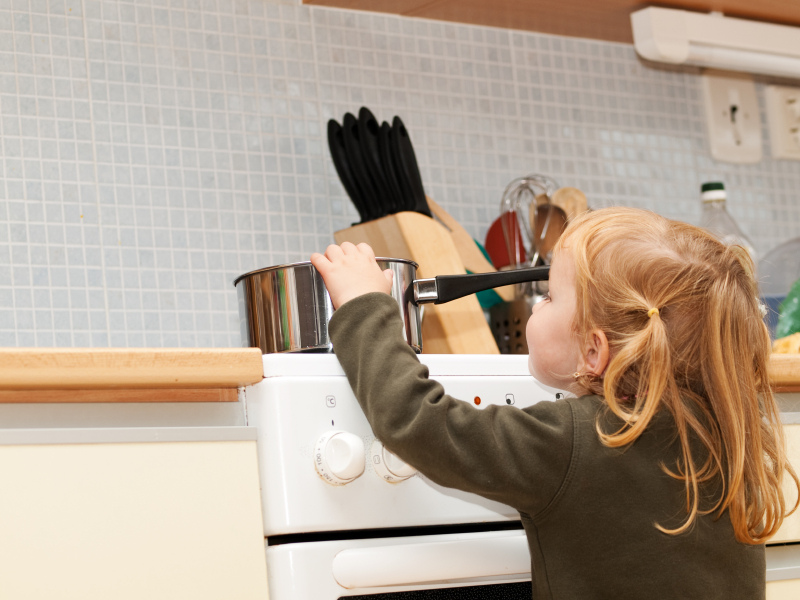Kitchens can be death traps at the best of times and having your children in and out of yours is virtually unavoidable. All is good and well when you bring your gorgeous little newborn home. There’s very unlikely that you’ll find them pulling out all the Tupperware from the cupboard or pouring out the cereal to the floor, but kids grow quicker than you imagine, and it won’t be long before they’re crawling around, putting every little thing in their mouths and putting their delicate little fingers into anything they can. Thankfully there are plenty of simple design options you can implement to improve safety levels in your kitchen.
Chances are, if you’re designing a kitchen from scratch, it’ll be happening before the plans for kids turns into the google searches of how to have a baby boy or how to have a baby girl. Whether you’re installing it on your own or you’ve been researching kitchen showrooms, there are plenty of safety-first decisions that you should be making regardless of the age or stage of your children. For instance, when it comes to layout it is optimal to ensure that the fridge or freezer are as far from the stove and oven as possible. This will help reduce the risk of hot pots or pans colliding with an unsuspecting fridge goer. Similarly, it is recommended that you refrain from putting your oven and stove top directly beneath a window. It is considered a safety risk due to the possibility of a gust of wind causing curtains or nearby flammable materials to come in contact with the hot surfaces and start a fire. When deciding on a floor material a high-quality laminate, wood, or other soft but durable materials will be safer than opting for tiles. Kids love to climb, and a fall onto tiles has a lot more potential for damage than that of a softer landing.
When picking out benchtops and cupboards it is ideal to make the materials durable and easy to clean. Look for the materials that are free from intricate designs or crevices as these are the hardest to clean. It’s no secret that having kids is messy business and they will likely want to be included in your cooking adventures and be enthusiastic about baking. Ideally your cupboards will be varied in height – the higher shelves for keeping things away from curious fingers and the lower shelves to allow for independent little helpers. Keeping glassware, spicy foods, alcohols and tempting treats out of reach will reduce potential stress when you discover your little ones have raided your cupboards for snacks. As they get a little more active and often increasingly curious, it might be necessary to invest in child lock barriers for cupboards. Where possible, you should opt to install slow-close hinges to all cupboards and doors. Little hands like to slam, and little fingers are very likely to whittle their way into little spaces.

Storage of any potentially dangerous items in your kitchen play a huge part when thinking safety for your children. Some might seem obnoxiously obvious such as knives, but it is exceptionally easy to underestimate your child’s abilities to get into the oddest of places. At the end of the day kids are very curious, and part of their tactile development will likely involve opening and finding things you might have thought were safely put away. Kids are very good examples of monkey see monkey do. Investing in a partitioned bin that has spots for recycling will ensure they can be a part of the process from a fairly young age. Just make sure that the lids are sealed and not easily opened by little hands as you don’t want them cutting their fingers on a stray tin can or broken bottle. A knife block is undoubtably a stylish feature to any bench top but is far from practical when you have young kids – perhaps you can pull it back out once they have a better understanding that it’s sharp and they mustn’t touch. All sharp objects should be kept out of reach and ideally behind some kind of child locked cupboard or drawer. The same can be said of any chemicals or outside products. It’s fairly common in a lot of homes to store everything from household cleaners to furniture oil stain or even deck cleaner under the sink. A very practical location that has stood the test of time. However, when considering the safety of young children, it’s advisable to find them a new home. This could be inside the house in a laundry space or if you have an easy access garage this would also work. The last thing you want is to discover your little one playing with chemicals.
Once you have all the safety aspects out of the way, it’ll be time to make things fun, inviting, and educational. It’s important that kids learn the skills to one day prepare and cook meals of their own and getting them enthusiastic for it from a young age will help them on their way. Making sure you have stools and other accessibility tools available will ensure you’re able to get whatever job done whilst still allowing them to be included. Chances are your children will spend a reasonable amount of time in your kitchen as they grow – especially if you often eat there. There will be plenty of amateur executive coaching taking place all over your home as they grow but teaching your kids organisation can easily be done in the kitchen. For example, keeping chores rosters and displaying their artwork on the walls. A stylish option would be to gets some blackboard paint and include a blackboard wall. This can age as your kids do – as a newborn it will be an ideal spot for you to keep notes and reminders for yourself, as they progress to toddlers it’s a great way to keep them entertained whilst you prepare a meal, and as they get into school years it’ll be perfect to leave them little notes and reminders.
